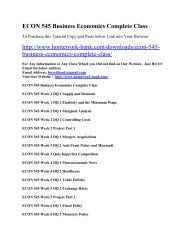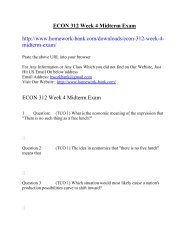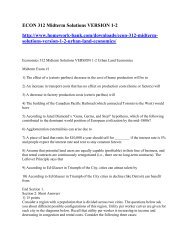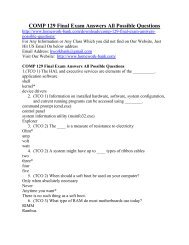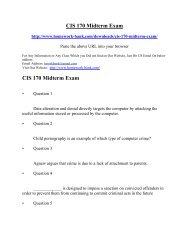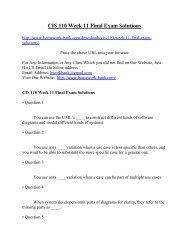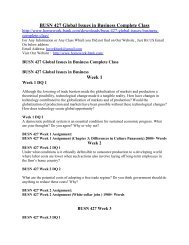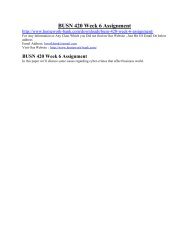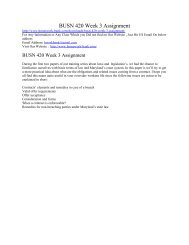ECO 550 Final Exam (36 Questions with Correct Answers)
For Any Information or Any Class Which you Did not find on Our Website , Just Hit US Email On below address Email Address: hworkbank@gmail.com Visit Our Website : http://www.homework-bank.com/
For Any Information or Any Class Which you Did not find on Our Website , Just Hit US Email On below address
Email Address: hworkbank@gmail.com
Visit Our Website : http://www.homework-bank.com/
Create successful ePaper yourself
Turn your PDF publications into a flip-book with our unique Google optimized e-Paper software.
<strong>ECO</strong> <strong>550</strong> <strong>Final</strong> <strong>Exam</strong> (<strong>36</strong> <strong>Questions</strong> <strong>with</strong><br />
<strong>Correct</strong> <strong>Answers</strong>)<br />
To Purchase this Tutorial Copy And Paste Below Link In Your Browser<br />
http://www.homework-bank.com/downloads/eco-<strong>550</strong>-final-exam-<strong>36</strong>-questions-correct-answers/<br />
For Any Information or Any Class Which you Did not find on Our Website , Just Hit US Email On below<br />
address<br />
Email Address: hworkbank@gmail.com<br />
Visit Our Website : http://www.homework-bank.com/<br />
<strong>ECO</strong> <strong>550</strong> <strong>Final</strong> <strong>Exam</strong> (<strong>36</strong> <strong>Questions</strong> <strong>with</strong> <strong>Correct</strong> <strong>Answers</strong>)<br />
Question 1<br />
The short-run cost function is:<br />
Answer<br />
where all inputs to the production process are variable<br />
relevant to decisions in which one or more inputs to the production process are fixed<br />
not relevant to optimal pricing and production output decisions<br />
crucial in making optimal investment decisions in new production facilities<br />
In a study of banking by asset size over time, we can find which asset sizes are tending to<br />
become more prominent. The size that is becoming more predominant is presumed to be least<br />
cost. This is called:<br />
Answer<br />
regression to the mean analysis.<br />
breakeven analysis.<br />
survivorship analysis.<br />
engineering cost analysis.<br />
a Willie Sutton analysis.<br />
Which of the following is not<br />
an assumption of the linear breakeven model:
Answer<br />
constant selling price per unit<br />
decreasing variable cost per unit<br />
fixed costs are independent of the output level<br />
a single product (or a constant mix of products) is being produced and sold<br />
all costs can be classified as fixed or variable<br />
Question 4<br />
A ____ total cost function implies that marginal costs ____ as output is increased.<br />
Answer<br />
linear; increase linearly<br />
quadratic; are constant<br />
cubic; increase linearly<br />
linear; are constant<br />
Long distance telephone service has become a competitive market. The average cost per call is<br />
$0.05 a minute, and it’s declining. The likely reason for the declining price for long distance<br />
service is:<br />
Answer<br />
Governmental pressure to lower the price<br />
Reduced demand for long distance service<br />
Entry into this industry pushes prices down<br />
Lower price for a barrel of crude oil<br />
Increased cost of providing long distance service<br />
What is the profit maximization point for a firm in a purely competitive environment?<br />
Answer
The output where<br />
The output where P < MC<br />
The output where P > MC<br />
The output where<br />
The output where AVC < P<br />
Question 7<br />
The problems of asymmetric information exchange arise ultimately because<br />
Answer<br />
one party to the exchange possesses different information than another<br />
one party has more information than another<br />
one party knows nothing<br />
one party cannot independently verify the information of another<br />
information is scarce<br />
Question 8<br />
An “experience good” is one that:<br />
Answer<br />
Only an expert can use<br />
Has undetectable quality when purchased<br />
Can be readily experienced simply by touching or tasting<br />
Improves <strong>with</strong> age, like a fine wine<br />
Question 9<br />
Of the following, which is not<br />
an economic rationale for public utility regulation?<br />
Answer
production process exhibiting increasing returns to scale<br />
constant cost industry<br />
avoidance of duplication of facilities<br />
protection of consumers from price discrimination<br />
Question 10<br />
____ as practiced by public utilities is designed to encourage greater usage and therefore spread<br />
the fixed costs of the utility’s plant over a larger number of units of output.<br />
Answer<br />
Peak load pricing<br />
Inverted block pricing<br />
Block pricing<br />
First degree price discrimination<br />
Question 11<br />
In natural monopoly, AC continuously declines due to economies in distribution or in<br />
production, which tends to found in industries which face increasing returns to scale. If price<br />
were set equal to marginal cost, then:<br />
Answer<br />
price would equal average cost.<br />
price would exceed average cost.<br />
price would be below average cost.<br />
price would be at the profit maximizing level for natural monopoly<br />
Question 12<br />
Regulatory agencies engage in all of the following activities except _______.<br />
Answer<br />
controlling entry into the regulated industries
overseeing the quality of service provided by the firms<br />
setting federal and state income tax rates on regulated firms<br />
setting prices that consumers will pay<br />
Question 13<br />
5 points<br />
In the Cournot duopoly model, each of the two firms, in determining its profit-maximizing priceoutput<br />
level, assumes that the other firm’s ____ will not change.<br />
Answer<br />
price<br />
output<br />
marketing strategy<br />
inventory<br />
Question 14<br />
Barometric price leadership exists when<br />
Answer<br />
one firm in the industry initiates a price change and the others follow it as a signal of changes in<br />
cost or demand in the industry.<br />
one firm imposes its best price on the rest of the industry.<br />
all firms agree to change prices simultaneously.<br />
one company forms a price umbrella for all others.<br />
the firms are all colluding.<br />
Question 15<br />
A(n) ____ is characterized by a relatively small number of firms producing a product.<br />
Answer
monopoly<br />
syndicate<br />
cooperative<br />
oligopoly<br />
Question 16<br />
Even ideal cartels tend to be unstable because<br />
Answer<br />
firms typically prefer competition to collusion as competition, because it leads to more profits.<br />
collusion leads to lowest possible overall profits in the industry.<br />
oligopolistic managers are extremely risk loving.<br />
firms can benefit by secretly selling more than they promised the other firms<br />
Question 17<br />
The starting point of many methods for predicting equilibrium strategy in sequential games is<br />
Answer<br />
designing proactive reactions to rival actions<br />
information sets<br />
uncertain outcomes<br />
backwards induction based on an explicit order of play<br />
endgame analysis<br />
Question 18<br />
Cooperation in repeated prisoner’s dilemma situations seems to be enhanced by all of the<br />
following except<br />
Answer<br />
limited punishment schemes
clarity of conditional rewards<br />
grim trigger strategy<br />
provocability–i.e., credible threats of punishment<br />
tit for tat strategy<br />
Question 19<br />
When there is no Equilibrium (or no Nash Equilibrium), we expect that:<br />
Answer<br />
the firms end up in the cooperative strategy.<br />
a firm will follow a randomized strategy.<br />
a firm will not care what it does.<br />
a firm will very likely have a dominant strategy.<br />
Question 20<br />
In making promises that are not guaranteed by third parties and in imposing penalties that are not<br />
enforced by third parties, all of the following are credibility-enhancing mechanisms except<br />
Answer<br />
establishing a bond forfeited by violating the commitment<br />
investing in a non-redeployable reputational asset tied to the promise or threat<br />
interrupting the communication of negotiated compromises<br />
offering a warranty<br />
delivering a hostage (e.g., a patent license triggered by violating the promise)<br />
Question 21<br />
____ is a new product pricing strategy which results in a high initial product price. This price is<br />
reduced over time as demand at the higher price is satisfied.<br />
Answer
Prestige pricing<br />
Price lining<br />
Skimming<br />
Incremental pricing<br />
Third-degree price discrimination exists whenever:<br />
Answer<br />
the seller knows exactly how much each potential customer is willing to pay and will charge<br />
accordingly.<br />
different prices are charged by blocks of services.<br />
the seller can separate markets by geography, income, age, etc., and charge different prices to<br />
these different groups.<br />
the seller will bargain <strong>with</strong> buyers in each of the markets to obtain the best possible price.<br />
Which of the statements about price discrimination is (are) false?<br />
Answer<br />
It must be possible to segment the market.<br />
It must be difficult to transfer the seller’s product from one market segment to another.<br />
Public utilities practice first-degree price discrimination.<br />
There must be differences in the elasticity of demand from one segment to another.<br />
The following are possible examples of price discrimination, EXCEPT:<br />
Answer<br />
prices in export markets are lower than for identical products in the domestic market.<br />
senior citizens pay lower fares on public transportation than younger people at the same time.<br />
a product sells at a higher price at location A than at location B, because transportation costs are<br />
higher from the factory to A.
subscription prices for a professional journal are higher when bought by a library than when<br />
bought by an individual<br />
Which of the following is not among the functions of contract?<br />
Answer<br />
to provide incentives for efficient reliance<br />
to reduce transaction costs<br />
to discourage the development of asymmetric information<br />
to provide risk allocation mechanisms<br />
Question 26<br />
When borrowers who do not intend to repay are able to hide their bad credit histories, a lender’s<br />
well-intentioned borrowers should<br />
Answer<br />
complain to regulatory authorities<br />
<strong>with</strong>draw their loan applications<br />
offer more collateral in exchange for lower interest charges<br />
divulge still more information on their loan applications<br />
hope for a pooling equilibrium<br />
Question 27<br />
When someone contracts to do a task but fails to put full effort into the performance of an<br />
agreement, yet the lack of effort is not independently verifiable, this lack of effort constitutes a<br />
Answer<br />
breach of contractual obligations<br />
denial of good guarantee<br />
loss of reputation<br />
moral hazard
Question 28<br />
Which of the following are not approaches to resolving the principal-agent problem?<br />
Answer<br />
ex ante incentive alignment<br />
deferred stock options<br />
ex post governance mechanism<br />
straight salary contracts<br />
monitoring by independent outside directors<br />
Question 29<br />
The lower the barriers to entry and exit, the more nearly a market structure fits the ____ market<br />
model.<br />
Answer<br />
monopolistic competition<br />
perfectly contestable<br />
oligopoly<br />
monopoly<br />
Question 30<br />
Industry A has market shares of 50, 30, and 20. Industry B has market shares of 45, 40, and 15.<br />
Hint: HHI = Σ (si2), where si is the market shares of the i-th firm in the industry.<br />
Answer<br />
The Herfindahl index for A is 100.<br />
The Herfindahl index for A is 3,800.<br />
The Herfindahl index for B is 3,600<br />
The Herfindahl index for A is greater than for B.
The Herfindahl index is for B is 4,000.<br />
Question 31<br />
____ occurs whenever a third party receives or bears costs arising from an economic transaction<br />
in which the individual (or group) is not a direct participant.<br />
Answer<br />
Pecuniary benefits and costs<br />
Externalities<br />
Intangibles<br />
Monopoly costs and benefits<br />
Question 32<br />
____ yields the same results as the theory of perfect competition, but requires substantially fewer<br />
assumptions than the perfectly competitive model.<br />
Answer<br />
Baumol’s sales maximization hypothesis<br />
The Pareto optimality condition<br />
The Cournot model<br />
The theory of contestable markets<br />
Question 33<br />
Which of the following would not be classified as a capital expenditure for decision-making<br />
purposes?<br />
Answer<br />
purchase of a building<br />
investment in a new milling machine<br />
purchase of 90-day Treasury Bills<br />
investment in a management training program
Question 34<br />
Capital expenditures:<br />
Answer<br />
are easily reversible<br />
are forms of operating expenditures<br />
Affect long-run future profitability<br />
Involve only money, not machinery<br />
Question 35<br />
The ____ method assumes that the cash flows over the life of the project are reinvested at the<br />
____.<br />
Answer<br />
net present value; computed internal rate of return<br />
internal rate of return; firm’s cost of capital<br />
net present value; firm’s cost of capital<br />
net present value; risk-free rate of return<br />
Question <strong>36</strong><br />
The weights used in calculating the firm’s weighted-average cost of capital are equal to the<br />
proportion of debt and equity ____.<br />
Answer<br />
used to finance the project<br />
used to finance the projects undertaken last year<br />
in the industry average capital structure<br />
in the firm’s target capital structure



